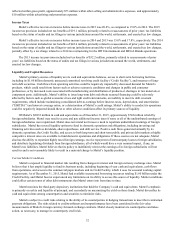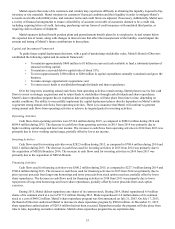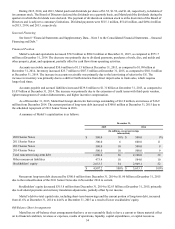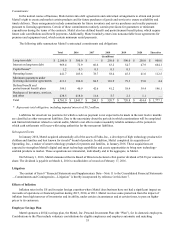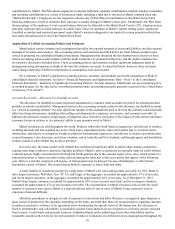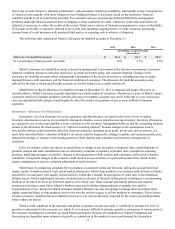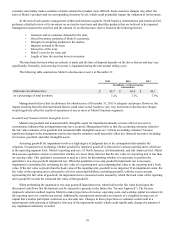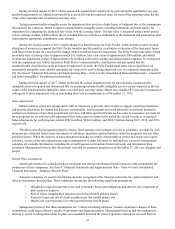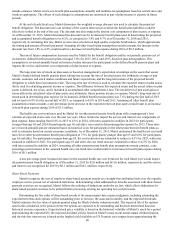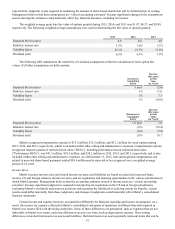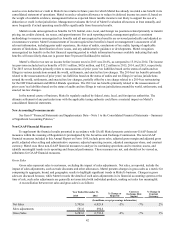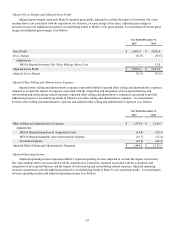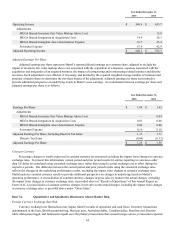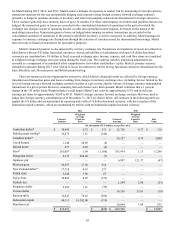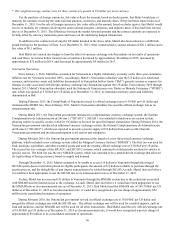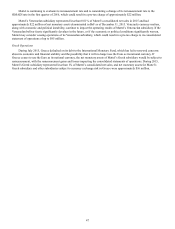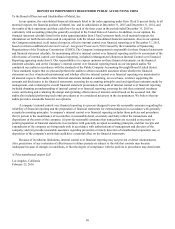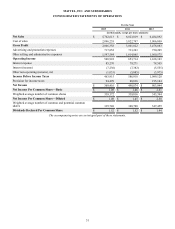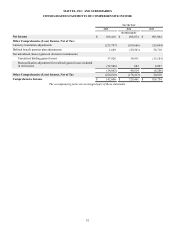Mattel 2015 Annual Report Download - page 46
Download and view the complete annual report
Please find page 46 of the 2015 Mattel annual report below. You can navigate through the pages in the report by either clicking on the pages listed below, or by using the keyword search tool below to find specific information within the annual report.
42
used as a tax deduction or credit in Mattel’s tax returns in future years for which Mattel has already recorded a tax benefit in its
consolidated statement of operations. Mattel records a valuation allowance to reduce its deferred income tax assets if, based on
the weight of available evidence, management believes expected future taxable income is not likely to support the use of a
deduction or credit in that jurisdiction. Management evaluates the level of Mattel’s valuation allowances at least annually, and
more frequently if actual operating results differ significantly from forecasted results.
Mattel records unrecognized tax benefits for US federal, state, local, and foreign tax positions related primarily to transfer
pricing, tax credits claimed, tax nexus, and apportionment. For each reporting period, management applies a consistent
methodology to measure unrecognized tax benefits and all unrecognized tax benefits are reviewed periodically and adjusted as
circumstances warrant. Mattel’s measurement of its unrecognized tax benefits is based on management’s assessment of all
relevant information, including prior audit experience, the status of audits, conclusions of tax audits, lapsing of applicable
statutes of limitations, identification of new issues, and any administrative guidance or developments. Mattel recognizes
unrecognized tax benefits in the first financial reporting period in which information becomes available indicating that such
benefits will more-likely-than-not (a greater than 50 percent likelihood) be realized.
Mattel’s effective tax rate on income before income taxes in 2015 was 20.4%, as compared to 15.0% in 2014. The income
tax provision included net tax benefits of $19.1 million, $42.6 million, and $32.2 million in 2015, 2014, and 2013, respectively.
The 2015 net tax benefits primarily relate to reassessments of prior years’ tax liabilities based on the status of audits and tax
filings in various jurisdictions around the world, settlements, and enacted tax law changes. The 2014 net tax benefits primarily
related to the reassessments of prior years’ tax liabilities based on the status of audits and tax filings in various jurisdictions
around the world, settlements, and enacted tax law changes, partially offset by a tax charge related to a 2014 tax restructuring
for the HIT Entertainment and MEGA Brands operations. The 2013 net tax benefits primarily related to the reassessments of
prior years’ tax liabilities based on the status of audits and tax filings in various jurisdictions around the world, settlements, and
enacted tax law changes.
In the normal course of business, Mattel is regularly audited by federal, state, local, and foreign tax authorities. The
ultimate settlement of any particular issue with the applicable taxing authority could have a material impact on Mattel’s
consolidated financial statements.
New Accounting Pronouncements
See Item 8 “Financial Statements and Supplementary Data—Note 1 to the Consolidated Financial Statements—Summary
of Significant Accounting Policies.”
Non-GAAP Financial Measures
To supplement the financial results presented in accordance with GAAP, Mattel presents certain non-GAAP financial
measures within the meaning of Regulation G promulgated by the Securities and Exchange Commission. The non-GAAP
financial measures included in this Annual Report on Form 10-K include gross sales, adjusted gross margin and adjusted gross
profit, adjusted other selling and administrative expenses, adjusted operating income, adjusted earnings per share, and constant
currency. Mattel uses these non-GAAP financial measures to analyze its continuing operations and to monitor, assess, and
identify meaningful trends in its operating and financial performance. These measures are not, and should not be viewed as,
substitutes for GAAP financial measures.
Gross Sales
Gross sales represent sales to customers, excluding the impact of sales adjustments. Net sales, as reported, include the
impact of sales adjustments, such as trade discounts and other allowances. Mattel presents changes in gross sales as a metric for
comparing its aggregate, brand, and geographic results to highlight significant trends in Mattel’s business. Changes in gross
sales are discussed because, while Mattel records the details of such sales adjustments in its financial accounting systems at the
time of sale, such sales adjustments are generally not associated with individual products, making net sales less meaningful.
A reconciliation between net sales and gross sales is as follows:
Year Ended December 31, % Change as
Reported
Currency
Exchange Rate
Impact
% Change in
Constant
Currency
2015 2014
(In millions, except percentage information)
Net Sales 5,702.6 6,023.8 -5%-7%2%
Sales adjustments 581.0 694.6
Gross Sales 6,283.6 6,718.4 -6%-7%1%


